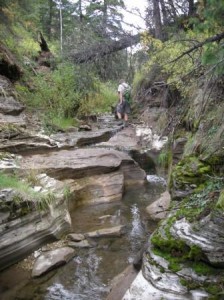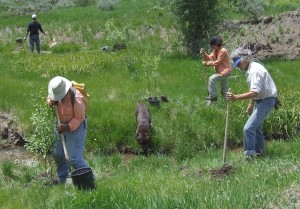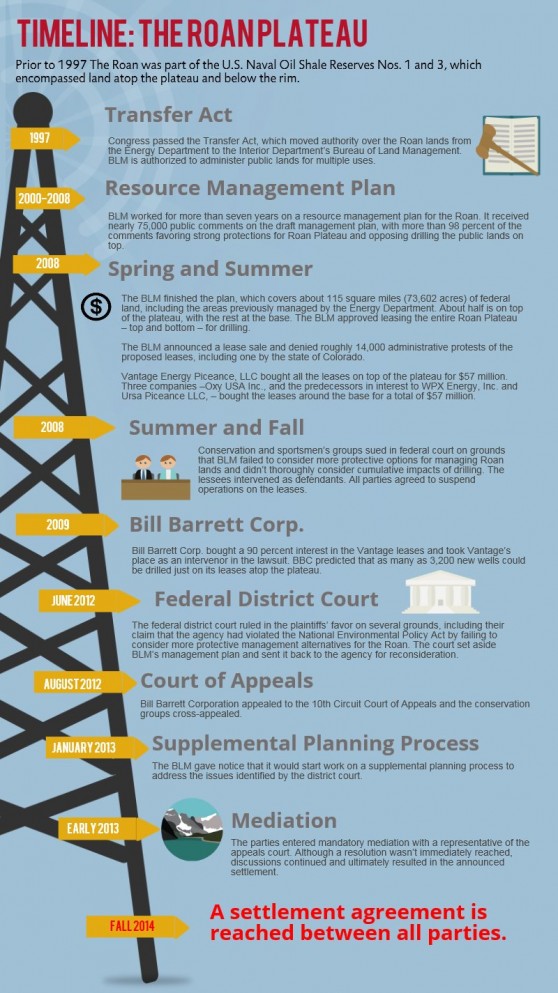It has been a long road in a legal battle that has stretched back more than six years - and advocacy and conservation efforts that stretch back more than a decade beyond that. But on November 21, a settlement of the legal battle over energy development on the Roan Plateau was announced, laying a "win-win" path forward that protects the Roan's most valued fish and wildlife habitats while also allowing for responsible energy development.
 The Roan Plateau supports remarkable natural values including habitat for rare native Colorado River cutthroat trout, scenic canyons and waterfalls, and outstanding big game habitat and hunting opportunities. TU's Grand Valley Anglers chapter has for nearly two decades worked on projects to benefit Trapper Creek and the unique native cutthroats it supports - Colorado Parks and Wildlife biologists found they are adapted to withstand warmer water temperatures than most cutthroats.
The Roan Plateau supports remarkable natural values including habitat for rare native Colorado River cutthroat trout, scenic canyons and waterfalls, and outstanding big game habitat and hunting opportunities. TU's Grand Valley Anglers chapter has for nearly two decades worked on projects to benefit Trapper Creek and the unique native cutthroats it supports - Colorado Parks and Wildlife biologists found they are adapted to withstand warmer water temperatures than most cutthroats.
The settlement resolves litigation in which Colorado Trout Unlimited, the National Wildlife Federation and eight other conservation groups were represented by Earthjustice. Among the key provisions of the settlement:
- The Bureau of Land Management (BLM) will cancel 17 of 19 leases held by Bill Barrett Corp. (BBC) atop the Roan within 60 days, and refund to BBC the money that was paid for those leases. These leases include about 90% of the acreage on top of the Plateau, including all of the native trout watersheds.
- BLM will prepare a new management plan for the Roan, and as part of their analysis will consider a "settlement alternative" with terms from the settlement agreement. While BLM legally cannot commit to adopting this alternative prior to completing their environmental analysis under the National Environmental Policy Act, all parties have agreed not to challenge the new plan so long as BLM adopts the settlement alternative.
- Under the settlement alternative the areas covered by the canceled leases atop the Roan Plateau will not be subject to oil and gas leasing. The two retained leases - located on Anvil Ridge in a portion of the Roan adjacent to existing drilling on private lands, outside of native cutthroat habitat, and lacking current public road access - will be allowed to develop responsibly with a limited number of carefully-sited well pads and management practices to minimize their impacts.
- The settlement alternative also allows for development under existing leases at the base of the Roan but strengthens "no surface occupancy" requirements, helping to secure important wildlife migration corridors, steep slopes, and other fragile resources.
The Roan Plateau is a great example of TU working together, with local volunteers from Grand Valley Anglers, Colorado TU staff and volunteer leaders, and National TU staff all helping contribute to our success. We've also benefited from great partners including our outstanding legal counsel with Earthjustice who have been a model of dedication and skill in guiding the legal challenge and settlement talks over several years.
The Roan could also be a model for balance on energy development. The oil and gas leaseholders - BBC, as well as Oxy, Ursa, and WPX (companies holding the leases at the Roan's base) - engaged with us in honest and constructive dialogue about a path for responsible energy development that includes strong protection for the Roan's unique fish and wildlife resources. Keeping disturbance out of the most important and sensitive habitats, while enabling responsible development to proceed on other portions of the Roan, is a great model for balance. We appreciate these companies working with us in good faith to achieve a responsible settlement for the Roan.
Our work isn't over -- we will continue our cutthroat protection and restoration projects on the Roan in the summer of 2015 and beyond, and we must work to ensure that the BLM adopts the "settlement alternative" in its planning process. Stay tuned for ways that you can get involved in the months ahead.















